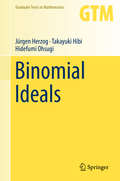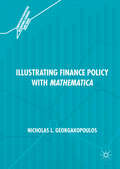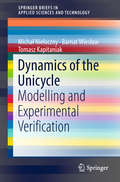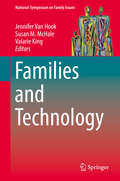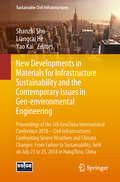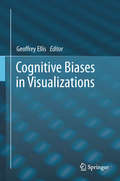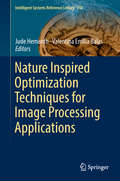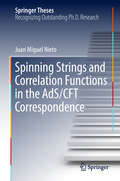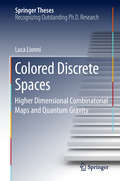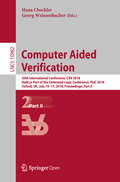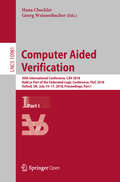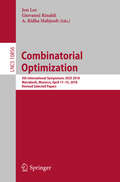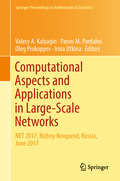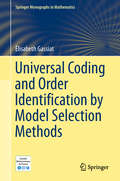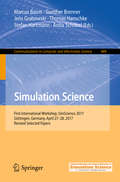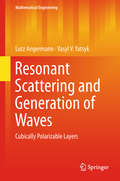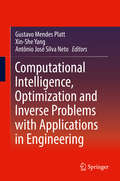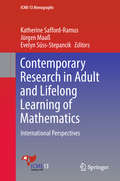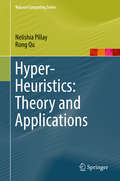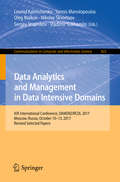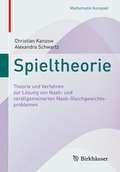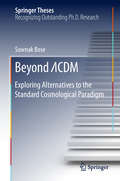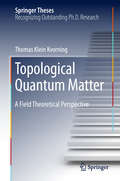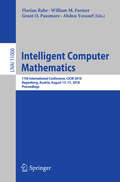- Table View
- List View
Binomial Ideals (Graduate Texts in Mathematics #279)
by Jürgen Herzog Takayuki Hibi Hidefumi OhsugiThis textbook provides an introduction to the combinatorial and statistical aspects of commutative algebra with an emphasis on binomial ideals. In addition to thorough coverage of the basic concepts and theory, it explores current trends, results, and applications of binomial ideals to other areas of mathematics. The book begins with a brief, self-contained overview of the modern theory of Gröbner bases and the necessary algebraic and homological concepts from commutative algebra. Binomials and binomial ideals are then considered in detail, along with a short introduction to convex polytopes. Chapters in the remainder of the text can be read independently and explore specific aspects of the theory of binomial ideals, including edge rings and edge polytopes, join-meet ideals of finite lattices, binomial edge ideals, ideals generated by 2-minors, and binomial ideals arising from statistics. Each chapter concludes with a set of exercises and a list of related topics and results that will complement and offer a better understanding of the material presented.Binomial Ideals is suitable for graduate students in courses on commutative algebra, algebraic combinatorics, and statistics. Additionally, researchers interested in any of these areas but familiar with only the basic facts of commutative algebra will find it to be a valuable resource.
Illustrating Finance Policy with Mathematica (Quantitative Perspectives on Behavioral Economics and Finance)
by Nicholas L. GeorgakopoulosStudents in various disciplines—from law and government to business and health policy—need to understand several quantitative aspects of finance (such as the capital asset pricing model or financial options) and policy analysis (e.g., assessing the weight of probabilistic evidence) but often have little quantitative background. This book illustrates those phenomena and explains how to illustrate them using the powerful visuals that computing can produce. Of particular interest to graduate students and scholars in need of sharper quantitative methods, this book introduces the reader to Mathematica, enables readers to use Mathematica to produce their own illustrations, and places specific emphasis on finance and policy as well as the foundations of probability theory.
Illustrating Finance Policy with Mathematica (Quantitative Perspectives on Behavioral Economics and Finance)
by Nicholas L. GeorgakopoulosStudents in various disciplines—from law and government to business and health policy—need to understand several quantitative aspects of finance (such as the capital asset pricing model or financial options) and policy analysis (e.g., assessing the weight of probabilistic evidence) but often have little quantitative background. This book illustrates those phenomena and explains how to illustrate them using the powerful visuals that computing can produce. Of particular interest to graduate students and scholars in need of sharper quantitative methods, this book introduces the reader to Mathematica, enables readers to use Mathematica to produce their own illustrations, and places specific emphasis on finance and policy as well as the foundations of probability theory.
Dynamics of the Unicycle: Modelling and Experimental Verification (SpringerBriefs in Applied Sciences and Technology)
by Michał Niełaczny Barnat Wiesław Tomasz KapitaniakThis book presents a three-dimensional model of the complete unicycle–unicyclist system. A unicycle with a unicyclist on it represents a very complex system. It combines Mechanics, Biomechanics and Control Theory into the system, and is impressive in both its simplicity and improbability. Even more amazing is the fact that most unicyclists don’t know that what they’re doing is, according to science, impossible – just like bumblebees theoretically shouldn’t be able to fly. This book is devoted to the problem of modeling and controlling a 3D dynamical system consisting of a single-wheeled vehicle, namely a unicycle and the cyclist (unicyclist) riding it. The equations of motion are derived with the aid of the rarely used Boltzmann–Hamel Equations in Matrix Form, which are based on quasi-velocities. The Matrix Form allows Hamel coefficients to be automatically generated, and eliminates all the difficulties associated with determining these quantities. The equations of motion are solved by means of Wolfram Mathematica. To more faithfully represent the unicyclist as part of the model, the model is extended according to the main principles of biomechanics. The impact of the pneumatic tire is investigated using the Pacejka Magic Formula model including experimental determination of the stiffness coefficient. The aim of control is to maintain the unicycle–unicyclist system in an unstable equilibrium around a given angular position. The control system, based on LQ Regulator, is applied in Wolfram Mathematica. Lastly, experimental validation, 3D motion capture using software OptiTrack – Motive:Body and high-speed cameras are employed to test the model’s legitimacy. The description of the unicycle–unicyclist system dynamical model, simulation results, and experimental validation are all presented in detail.
Families and Technology (National Symposium on Family Issues #9)
by Jennifer Van Hook Susan M. McHale Valarie KingThis timely reference takes a rigorous look at the myriad ways technology, from smartphones to dating apps to social media, is affecting family life and opening new areas for study. The book features cross-disciplinary perspectives on current trends in the role of technology in couple and family contexts. It focuses on the roles of parents in monitoring children’s screen time, of technology in relationship formation, and of technology in changing family dynamics. Nuanced coverage considers the emerging conflicts and paradoxes associated with digital family life—closeness versus isolation, children versus parents as experts, and privacy versus surveillance. Contributors also identify new research opportunities as family roles and structures continue to evolve and technology becomes a greater lens for family studies.Among the topics covered:How parents manage young children’s mobile media useAdolescents as the family technology innovatorsOnline dating: changing intimacy one swipe at a timeTechnology in relational systems: roles, rules, and boundariesTelevision “effects” on international family changeInterplay between families and technology: future investigationsFamilies and Technology is a valuable resource for researchers and students in the fields of family studies, sociology, marriage and family therapy, social welfare, public health, and psychology. The book also appeals to policymakers and human services personnel dedicated to better understanding the impact of rapidly spreading technologies on families around the globe.
New Developments in Materials for Infrastructure Sustainability and the Contemporary Issues in Geo-environmental Engineering: Proceedings of the 5th GeoChina International Conference 2018 – Civil Infrastructures Confronting Severe Weathers and Climate Changes: From Failure to Sustainability, held on July 23 to 25, 2018 in HangZhou, China (Sustainable Civil Infrastructures)
by Shanzhi Shu Liangcai He Yao KaiThis book contains research papers focusing on recent advances throughout the world in theories and technologies of geotechnical engineering and the relevant disciplines. Topics includes: numerical modeling, earthquake engineering, geomaterial application in soil improvement and geo-environmental engineering, foundation engineering, and geo-environmental engineering.. Papers were selected from the 5th GeoChina International Conference 2018 – Civil Infrastructures Confronting Severe Weathers and Climate Changes: From Failure to Sustainability, held on July 23 to 25, 2018 in HangZhou, China.
Cognitive Biases in Visualizations
by Geoffrey EllisThis book brings together the latest research in this new and exciting area of visualization, looking at classifying and modelling cognitive biases, together with user studies which reveal their undesirable impact on human judgement, and demonstrating how visual analytic techniques can provide effective support for mitigating key biases. A comprehensive coverage of this very relevant topic is provided though this collection of extended papers from the successful DECISIVe workshop at IEEE VIS, together with an introduction to cognitive biases and an invited chapter from a leading expert in intelligence analysis.Cognitive Biases in Visualizations will be of interest to a wide audience from those studying cognitive biases to visualization designers and practitioners. It offers a choice of research frameworks, help with the design of user studies, and proposals for the effective measurement of biases. The impact of human visualization literacy, competence and human cognition on cognitive biases are also examined, as well as the notion of system-induced biases. The well referenced chapters provide an excellent starting point for gaining an awareness of the detrimental effect that some cognitive biases can have on users’ decision-making. Human behavior is complex and we are only just starting to unravel the processes involved and investigate ways in which the computer can assist, however the final section supports the prospect that visual analytics, in particular, can counter some of the more common cognitive errors, which have been proven to be so costly.
Nature Inspired Optimization Techniques for Image Processing Applications (Intelligent Systems Reference Library #150)
by Jude Hemanth Valentina Emilia BalasThis book provides a platform for exploring nature-inspired optimization techniques in the context of imaging applications. Optimization has become part and parcel of all computational vision applications, and since the amount of data used in these applications is vast, the need for optimization techniques has increased exponentially. These accuracy and complexity are a major area of concern when it comes to practical applications. However, these optimization techniques have not yet been fully explored in the context of imaging applications. By presenting interdisciplinary concepts, ranging from optimization to image processing, the book appeals to a broad readership, while also encouraging budding engineers to pursue and employ innovative nature-inspired techniques for image processing applications.
Spinning Strings and Correlation Functions in the AdS/CFT Correspondence (Springer Theses)
by Juan Miguel NietoThis book addresses several aspects of the integrable structure of the AdS/CFT correspondence. In particular it presents computations made on both sides of the AdS/CFT correspondence, at weak and at strong coupling. On the string theory side of the correspondence, the book focuses on the evaluation of the energy spectrum of closed string solutions moving in some deformed backgrounds that preserve integrability. On the gauge theory side, it explores various formal problems arising in the computation of two and three-point functions by means of the Algebraic Bethe Ansatz and the Quantum Inverse Scattering method. The book features numerous results on integrability in the context of the AdS/CFT correspondence. Self-contained and pedagogical, it includes general discussions and detailed presentations on the use of integrable systems techniques and their applications.
Colored Discrete Spaces: Higher Dimensional Combinatorial Maps and Quantum Gravity (Springer Theses)
by Luca LionniThis book provides a number of combinatorial tools that allow a systematic study of very general discrete spaces involved in the context of discrete quantum gravity. In any dimension D, we can discretize Euclidean gravity in the absence of matter over random discrete spaces obtained by gluing families of polytopes together in all possible ways. These spaces are then classified according to their curvature. In D=2, it results in a theory of random discrete spheres, which converge in the continuum limit towards the Brownian sphere, a random fractal space interpreted as a quantum random space-time. In this limit, the continuous Liouville theory of D=2 quantum gravity is recovered. Previous results in higher dimension regarded triangulations, converging towards a continuum random tree, or gluings of simple building blocks of small sizes, for which multi-trace matrix model results are recovered in any even dimension. In this book, the author develops a bijection with stacked two-dimensional discrete surfaces for the most general colored building blocks, and details how it can be used to classify colored discrete spaces according to their curvature. The way in which this combinatorial problem arrises in discrete quantum gravity and random tensor models is discussed in detail.
Computer Aided Verification: 30th International Conference, CAV 2018, Held as Part of the Federated Logic Conference, FloC 2018, Oxford, UK, July 14-17, 2018, Proceedings, Part II (Lecture Notes in Computer Science #10982)
by Hana Chockler Georg WeissenbacherThis open access two-volume set LNCS 10980 and 10981 constitutes the refereed proceedings of the 30th International Conference on Computer Aided Verification, CAV 2018, held in Oxford, UK, in July 2018. The 52 full and 13 tool papers presented together with 3 invited papers and 2 tutorials were carefully reviewed and selected from 215 submissions. The papers cover a wide range of topics and techniques, from algorithmic and logical foundations of verification to practical applications in distributed, networked, cyber-physical, and autonomous systems. They are organized in topical sections on model checking, program analysis using polyhedra, synthesis, learning, runtime verification, hybrid and timed systems, tools, probabilistic systems, static analysis, theory and security, SAT, SMT and decisions procedures, concurrency, and CPS, hardware, industrial applications.
Computer Aided Verification: 30th International Conference, CAV 2018, Held as Part of the Federated Logic Conference, FloC 2018, Oxford, UK, July 14-17, 2018, Proceedings, Part I (Lecture Notes in Computer Science #10981)
by Hana Chockler Georg WeissenbacherThis open access two-volume set LNCS 10980 and 10981 constitutes the refereed proceedings of the 30th International Conference on Computer Aided Verification, CAV 2018, held in Oxford, UK, in July 2018. The 52 full and 13 tool papers presented together with 3 invited papers and 2 tutorials were carefully reviewed and selected from 215 submissions. The papers cover a wide range of topics and techniques, from algorithmic and logical foundations of verification to practical applications in distributed, networked, cyber-physical, and autonomous systems. They are organized in topical sections on model checking, program analysis using polyhedra, synthesis, learning, runtime verification, hybrid and timed systems, tools, probabilistic systems, static analysis, theory and security, SAT, SMT and decisions procedures, concurrency, and CPS, hardware, industrial applications.
Combinatorial Optimization: Third International Symposium, Isco 2014, Lisbon, Portugal, March 5-7, 2014, Revised Selected Papers (Lecture Notes in Computer Science #8596)
by A. Ridha Mahjoub Giovanni Rinaldi Jon LeeThis book constitutes the thoroughly refereed post-conference proceedings of the 5th International Symposium on Combinatorial Optimization, ISCO 2017, held in Marrakesh, Marocco, in April 2018. The 35 revised full papers presented in this book were carefully reviewed and selected from 75 submissions. The symposium aims to bring together researchers from all the communities related to combinatorial optimization, including algorithms and complexity, mathematical programming and operations research.
Computational Aspects and Applications in Large-Scale Networks: NET 2017, Nizhny Novgorod, Russia, June 2017 (Springer Proceedings in Mathematics & Statistics #247)
by Valery A. Kalyagin Panos M. Pardalos Oleg Prokopyev Irina UtkinaContributions in this volume focus on computationally efficient algorithms and rigorous mathematical theories for analyzing large-scale networks. Researchers and students in mathematics, economics, statistics, computer science and engineering will find this collection a valuable resource filled with the latest research in network analysis. Computational aspects and applications of large-scale networks in market models, neural networks, social networks, power transmission grids, maximum clique problem, telecommunication networks, and complexity graphs are included with new tools for efficient network analysis of large-scale networks. This proceeding is a result of the 7th International Conference in Network Analysis, held at the Higher School of Economics, Nizhny Novgorod in June 2017. The conference brought together scientists, engineers, and researchers from academia, industry, and government.
Universal Coding and Order Identification by Model Selection Methods (Springer Monographs in Mathematics)
by Élisabeth Gassiat Anna Ben-HamouThe purpose of these notes is to highlight the far-reaching connections between Information Theory and Statistics. Universal coding and adaptive compression are indeed closely related to statistical inference concerning processes and using maximum likelihood or Bayesian methods. The book is divided into four chapters, the first of which introduces readers to lossless coding, provides an intrinsic lower bound on the codeword length in terms of Shannon’s entropy, and presents some coding methods that can achieve this lower bound, provided the source distribution is known. In turn, Chapter 2 addresses universal coding on finite alphabets, and seeks to find coding procedures that can achieve the optimal compression rate, regardless of the source distribution. It also quantifies the speed of convergence of the compression rate to the source entropy rate. These powerful results do not extend to infinite alphabets. In Chapter 3, it is shown that there are no universal codes over the class of stationary ergodic sources over a countable alphabet. This negative result prompts at least two different approaches: the introduction of smaller sub-classes of sources known as envelope classes, over which adaptive coding may be feasible, and the redefinition of the performance criterion by focusing on compressing the message pattern. Finally, Chapter 4 deals with the question of order identification in statistics. This question belongs to the class of model selection problems and arises in various practical situations in which the goal is to identify an integer characterizing the model: the length of dependency for a Markov chain, number of hidden states for a hidden Markov chain, and number of populations for a population mixture. The coding ideas and techniques developed in previous chapters allow us to obtain new results in this area. This book is accessible to anyone with a graduate level in Mathematics, and will appeal to information theoreticians and mathematical statisticians alike. Except for Chapter 4, all proofs are detailed and all tools needed to understand the text are reviewed.
Simulation Science: First International Workshop, SimScience 2017, Göttingen, Germany, April 27–28, 2017, Revised Selected Papers (Communications in Computer and Information Science #889)
by Marcus Baum Gunther Brenner Jens Grabowski Thomas Hanschke Stefan Hartmann Anita SchöbelThis book constitutes the thoroughly refereed proceedings of the Clausthal-Göttingen International Workshop on Simulation Science, held in Göttingen, Germany, in April 2017. The 16 full papers presented were carefully reviewed and selected from 40 submissions. The papers are organized in topical sections on simulation and optimization in networks, simulation of materials, distributed simulations.
Resonant Scattering and Generation of Waves: Cubically Polarizable Layers (Mathematical Engineering)
by Lutz Angermann Vasyl V. YatsykThis monograph deals with theoretical aspects and numerical simulations of the interaction of electromagnetic fields with nonlinear materials. It focuses in particular on media with nonlinear polarization properties. It addresses the direct problem of nonlinear Electrodynamics, that is to understand the nonlinear behavior in the induced polarization and to analyze or even to control its impact on the propagation of electromagnetic fields in the matter. The book gives a comprehensive presentation of the results obtained by the authors during the last decade and put those findings in a broader, unified context and extends them in several directions.It is divided into eight chapters and three appendices. Chapter 1 starts from the Maxwell’s equations and develops a wave propagation theory in plate-like media with nonlinear polarizability. In chapter 2 a theoretical framework in terms of weak solutions is given in order to prove the existence and uniqueness of a solution of the semilinear boundary-value problem derived in the first chapter. Chapter 3 presents a different approach to the solvability theory of the reduced frequency-domain model. Here the boundary-value problem is reduced to finding solutions of a system of one-dimensional nonlinear Hammerstein integral equations. Chapter 4 describes an approach to the spectral analysis of the linearized system of integral equations. Chapters 5 and 6 are devoted to the numerical approximation of the solutions of the corresponding mathematical models. Chapter 7 contains detailed descriptions, discussions and evaluations of the numerical experiments. Finally, chapter 8 gives a summary of the results and an outlook for future work.
Computational Intelligence, Optimization and Inverse Problems with Applications in Engineering
by Gustavo Mendes Platt Xin-She Yang Antônio José Silva NetoThis book focuses on metaheuristic methods and its applications to real-world problems in Engineering. The first part describes some key metaheuristic methods, such as Bat Algorithms, Particle Swarm Optimization, Differential Evolution, and Particle Collision Algorithms. Improved versions of these methods and strategies for parameter tuning are also presented, both of which are essential for the practical use of these important computational tools. The second part then applies metaheuristics to problems, mainly in Civil, Mechanical, Chemical, Electrical, and Nuclear Engineering. Other methods, such as the Flower Pollination Algorithm, Symbiotic Organisms Search, Cross-Entropy Algorithm, Artificial Bee Colonies, Population-Based Incremental Learning, Cuckoo Search, and Genetic Algorithms, are also presented. The book is rounded out by recently developed strategies, or hybrid improved versions of existing methods, such as the Lightning Optimization Algorithm, Differential Evolution with Particle Collisions, and Ant Colony Optimization with Dispersion – state-of-the-art approaches for the application of computational intelligence to engineering problems.The wide variety of methods and applications, as well as the original results to problems of practical engineering interest, represent the primary differentiation and distinctive quality of this book. Furthermore, it gathers contributions by authors from four countries – some of which are the original proponents of the methods presented – and 18 research centers around the globe.
Contemporary Research in Adult and Lifelong Learning of Mathematics: International Perspectives (ICME-13 Monographs)
by Katherine Safford-Ramus Jürgen Maaß Evelyn Süss-StepancikThis book is a selection of 15 papers developed by participants in ICME 13 held in Hamburg , presenting insights from the latest research on the andragogy of adult and lifelong learning of mathematics. It also investigates open questions, such as numeracy and mathematics skills, social and psychological influences on learning environments, as well as economic and political demands. The chapters offer examples, while at the same time highlighting important directions for further research. The book is divided into four parts: The first section provides an overview on the concept of “numeracy”, and the second focuses on adult students who are learning mathematics; the third part presents a teachers’ focus and the final part covers overarching themes. The book is of interest to classroom teachers, university teacher educators, and professional development providers.
Hyper-Heuristics: Theory and Applications (Natural Computing Series)
by Nelishia Pillay Rong QuThis introduction to the field of hyper-heuristics presents the required foundations and tools and illustrates some of their applications. The authors organized the 13 chapters into three parts. The first, hyper-heuristic fundamentals and theory, provides an overview of selection constructive, selection perturbative, generation constructive and generation perturbative hyper-heuristics, and then a formal definition of hyper-heuristics. The chapters in the second part of the book examine applications of hyper-heuristics in vehicle routing, nurse rostering, packing and examination timetabling. The third part of the book presents advanced topics and then a summary of the field and future research directions. Finally the appendices offer details of the HyFlex framework and the EvoHyp toolkit, and then the definition, problem model and constraints for the most tested combinatorial optimization problems. The book will be of value to graduate students, researchers, and practitioners.
Data Analytics and Management in Data Intensive Domains: XIX International Conference, DAMDID/RCDL 2017, Moscow, Russia, October 10–13, 2017, Revised Selected Papers (Communications in Computer and Information Science #822)
by Leonid Kalinichenko Yannis Manolopoulos Oleg Malkov Nikolay Skvortsov Sergey Stupnikov Vladimir SukhomlinThis book constitutes the refereed proceedings of the 19th International Conference on Data Analytics and Management in Data Intensive Domains, DAMDID/RCDL 2017, held in Moscow, Russia, in October 2017.The 16 revised full papers presented together with three invited papers were carefully reviewed and selected from 75 submissions. The papers are organized in the following topical sections: data analytics; next generation genomic sequencing: challenges and solutions; novel approaches to analyzing and classifying of various astronomical entities and events; ontology population in data intensive domains; heterogeneous data integration issues; data curation and data provenance support; and temporal summaries generation.
Spieltheorie: Theorie und Verfahren zur Lösung von Nash- und verallgemeinerten Nash-Gleichgewichtsproblemen (Mathematik Kompakt)
by Christian Kanzow Alexandra SchwartzDas Buch gibt eine Einführung in einige zentrale Konzepte der (mathematischen) Spieltheorie und legt seinen Fokus dabei auf die Lösung von Nash- und verallgemeinerten Nash-Gleichgewichtsproblemen. Die meisten Probleme der Spieltheorie lassen sich nicht von Hand lösen; stattdessen ist man auf geeignete numerische Verfahren angewiesen, mit deren Hilfe zumindest eine Näherungslösung berechnet werden kann. Einen Schwerpunkt dieses Buches bilden daher eine ganze Reihe von Methoden meist neueren Datums, die hier erstmals in Buchform präsentiert werden und zur numerischen Lösung von Nash- und verallgemeinerten Nash-Gleichgewichtsproblemen verwendet werden können. Aber auch Existenz- und Eindeutigkeitssätze sowie Zwei-Personen-Spiele werden ausführlich diskutiert. Darüber hinaus werden in eigenen Abschnitten die benötigten mathematischen Grundlagen zur Verfügung gestellt. Dazu gehören Aussagen über konvexe und monotone Funktionen sowie Optimalitätsbedingungen aus der restringierten Optimierung.
Beyond ΛCDM: Exploring Alternatives to the Standard Cosmological Paradigm (Springer Theses)
by Sownak BoseThis book employs computer simulations of ‘artificial’ Universes to investigate the properties of two popular alternatives to the standard candidates for dark matter (DM) and dark energy (DE). It confronts the predictions of theoretical models with observations using a sophisticated semi-analytic model of galaxy formation. Understanding the nature of dark matter (DM) and dark energy (DE) are two of the most central problems in modern cosmology. While their important role in the evolution of the Universe has been well established—namely, that DM serves as the building blocks of galaxies, and that DE accelerates the expansion of the Universe—their true nature remains elusive. In the first half, the authors consider ‘sterile neutrino’ DM, motivated by recent claims that these particles may have finally been detected. Using sophisticated models of galaxy formation, the authors find that future observations of the high redshift Universe and faint dwarf galaxies in the Local Group can place strong constraints on the sterile neutrino scenario. In the second half, the authors propose and test novel numerical algorithms for simulating Universes with a ‘modified’ theory of gravity, as an alternative explanation to accelerated expansion. The authors’ techniques improve the efficiency of these simulations by more than a factor of 20 compared to previous methods, inviting the readers into a new era for precision cosmological tests of gravity.
Topological Quantum Matter: A Field Theoretical Perspective (Springer Theses)
by Thomas Klein KvorningThis book offers a theoretical description of topological matter in terms of effective field theories, and in particular topological field theories, focusing on two main topics: topological superconductors and topological insulators.Even though there is vast literature on these subjects, the book fills an important gap by providing a concise introduction to both topological order and symmetry-protected phases using a modern mathematical language, and developing the theoretical concepts by highlighting the physics and the physical properties of the systems. Further, it discusses in detail the topological interactions for topologically ordered matter, and the response to smooth external fields for symmetry protected matter. The book also covers more specialized topics that cannot be found elsewhere. Specifically, the response of superconductors to geometry, including the newly discovered geo-Meissner effect; and a correction to the usual Meissner effect, only present in the topologically interesting chiral superconductors.
Intelligent Computer Mathematics: 11th International Conference, CICM 2018, Hagenberg, Austria, August 13-17, 2018, Proceedings (Lecture Notes in Computer Science #11006)
by Florian Rabe William M. Farmer Grant O. Passmore Abdou YoussefThis book constitutes the refereed proceedings of the 11th International Conference on Intelligent Computer Mathematics, CICM 2018, held in Hagenberg, Austria, in August 2018. The 23 full papers presented were carefully reviewed and selected from a total of 36 submissions. The papers focos on the Calculemus, Digital Mathematics Libraries, and Mathematical Knowledge Management tracks which also correspond to the subject areas of the predecessor meetings. Orthogonally, the Systems and Projects track called for descriptions of digital resources, such as data and systems, and of projects, whether old, current, or new, and survey papers covering any topics of relevance to the CICM community.
